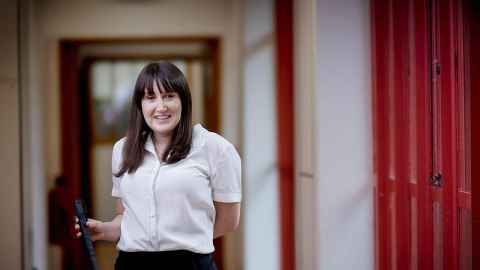Researcher harnesses firsthand experience
4 June 2025
Alix Coysh began losing her sight as a result of a genetic condition while still in her teens. Now, she tells James Fyfe, her research could lead to potential therapies that restore the sight of those with the same condition.

At 17, Dr Alix Coysh was determined to study science at university, despite being told her inherited eye disease would make it impossible to pursue an academic career. Today, not only has she earned a PhD from the University of Auckland, but she’s also a research fellow in the School of Biological Sciences, investigating the very condition that took her sight.
Alix has retinitis pigmentosa (RP), a genetic eye disorder that has gradually killed the photoreceptor cells in her retina, leaving her legally blind. RP is classified as a rod cone dystrophy; it first affects night vision, contrast detection and peripheral sight before progressing to colour blindness and central vision loss, making it difficult to read and recognise faces.
“I have no useful vision,” Alix explains. “I can detect light and vague shapes, but it’s not something I rely on.”
Fully sighted until her mid-teens, Alix, now 31, first noticed issues with her vision around age 11 when a teacher observed she had trouble reading faint writing on the whiteboard. By 15, after numerous visits to optometrists and ophthalmologists, she was diagnosed with RP.
“Accepting the diagnosis took a decade. I didn’t understand what going blind meant or how my future would look.”
To make things harder, her two younger siblings were also later diagnosed with RP.
“I knew firsthand what struggles lay ahead for them, and I felt a responsibility to lead by example,” she says.
As her vision declined, Alix embraced tools and technology to navigate and access the world.
“The more vision I lost and the better I got at adapting, the easier it actually became. Now, I see those adaptations as strengths. They’ve built my problem-solving skills, resilience and drive – all of which fuel my research.”
One major hurdle Alix initially faced was being discouraged by a University staff member from pursuing a career in science. It was suggested she try her hand at something more “accessible”, like being a masseuse or musician.
The more vision I lost and the better I got at adapting, the easier it actually became.
Alix says such misconceptions form harmful societal barriers and often stem from a lack of awareness about the role that adaptive technologies can play in enabling blind professionals to carry out their work. Now she hopes to break down those barriers for others.
Today, Alix specialises in bioinformatics – a field that harnesses computers to analyse and understand biological data, such as DNA sequencing results.
During her masters and PhD, which she completed under Professor Stefan Bohlander in the Faculty of Medical and Health Sciences, she concentrated on using her skill set to identify genetic mutations and chromosomal changes causing leukaemia and multiple myeloma. That experience prepared her for her current work – tackling the very mutation that led to her blindness.
Now, working with Professor Russell Snell in the School of Biological Sciences, she is using sheep models to study how genetic mutations drive RP. The goal? To develop gene therapies that could halt the disease and potentially restore lost vision.
“We’re in an exciting position where, with the right collaboration, awareness and support, we could translate therapies from the lab to patients with a relatively quick turnaround,” says Alix.
“Gene therapies have the potential to be long-term, one-time treatments that can transform the lives of those affected by RP. We’re already seeing life-changing success stories from gene therapy trials around the world, proving that this approach is more than just a possibility, it’s within reach.”
This article first appeared in the Autumn 2025 issue of Ingenio.